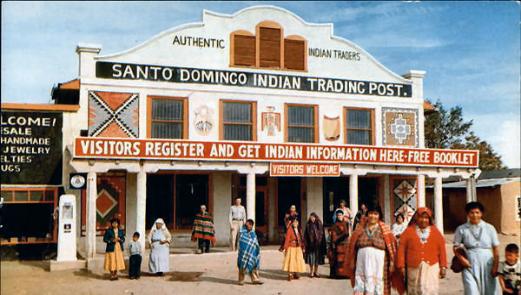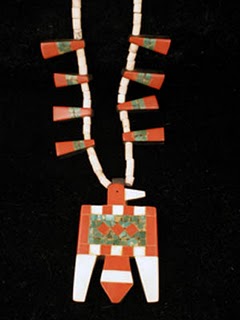>
The Santo Domingo have been making jewelry for hundreds of years, and have the longest traditions in making jewelry of the Southwest Indians. Jewelry making was the Santo Domingo Indians main source of income from the late 1800's, and all members of the family made jewelry, and each would have a special jewelry making skill or responsibility for each item produced. Santo Domingo Indians are pictured above at the village Trading Post, where they sold jewelry for the tourist trade. Santo Domingo Indian jewelry artisans specialize in shell and stone designs. Small beads are strung onto wire or nylon to make handsome multi-strand necklaces. The diameter of the beads can be very small or quite large and they are called heishi by the Santo Domingos. The Santo Domingo Indian jewelry incorporated heishi or rolled beads, which are made of shell, turquoise and coral. These necklaces and a type of earrings called jaclas, which consisted of short loops of turquoise heishi (often combined with coral beads), were extremely valuable as trade material, and the Santo Domingo exchanged or sold them for almost everything they needed. The Santo Domingo could get shell and gemstones from many sources. Turquoise came from the nearby Cerrillos mines, and they got scraps of turquoise by cutting beads from necklaces made decades before for ceremomial use. Turquoise was used for the overlay on the tabs, along with jet (or occasionally black plastic) and white plastic. Santo Domingo Indian oral history shows that by late 1920, they began to handcraft thunderbird pendants to hang from their necklaces. Birds were the only life form they could use to decorate jewelry or pottery, but all types of bird designs could be utilized. There are many misconceptions about a fascinating type of jewelry made by American Indians at the Santo Domingo Pueblo in New Mexico in the twentieth century. Some people refer to it as Depression jewelry because of the period in which it was supposedly made, others refer to it as battery-backed jewelry because of some of the materials used in making it. The makers themselves referred to it as thunderbird jewelry due to the major motif found on necklace pendants. By any name, it should be considered one of the truest traditional folk art forms of all Native American jewelry, for any changes made during its evolution came from the artists them-selves, even as they created it to appeal to the tourists who began flocking to the Southwest at the end of the nineteenth century. Below is a 1930's Santo Domingo Indian thunderbird necklace with tabs. |




In addition to making heishi necklaces and jaclas for trade, the
Santo Domingo crafted jewelry for specific ceremonies,
especially the Corn Ceremony. These were usually necklaces
which had large, geometric mosaic inlay patterns hanging from
them. They were made from shell, turquoise, and jet inlay in
beautiful and precise patterns.
At right: Photo of Santo Domingo Indian Dressed for the Corn
Ceremony Wearing the Necklace.
Today, the Santo Domingo Indian jewelry artisan also handcrafts
these beautiful necklaces for sale to the general public.
See these necklaces for sale- click here.
Another style of Santo Domingo necklace consists of tear-shaped
"tabs" strung on heishi. The tabs were made from bone overlaid
in the traditional mosaic style with bits of turquoise, jet, and
shell.
These necklaces are also sometimes identified as Depression
jewelry, but they were certainly made earlier than that, and are
still made today. See these necklaces for sale- click here.
Santo Domingo crafted jewelry for specific ceremonies,
especially the Corn Ceremony. These were usually necklaces
which had large, geometric mosaic inlay patterns hanging from
them. They were made from shell, turquoise, and jet inlay in
beautiful and precise patterns.
At right: Photo of Santo Domingo Indian Dressed for the Corn
Ceremony Wearing the Necklace.
Today, the Santo Domingo Indian jewelry artisan also handcrafts
these beautiful necklaces for sale to the general public.
See these necklaces for sale- click here.
Another style of Santo Domingo necklace consists of tear-shaped
"tabs" strung on heishi. The tabs were made from bone overlaid
in the traditional mosaic style with bits of turquoise, jet, and
shell.
These necklaces are also sometimes identified as Depression
jewelry, but they were certainly made earlier than that, and are
still made today. See these necklaces for sale- click here.

